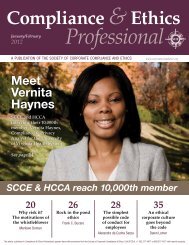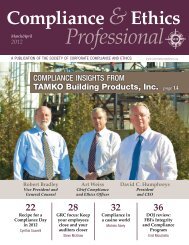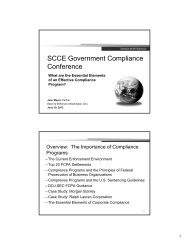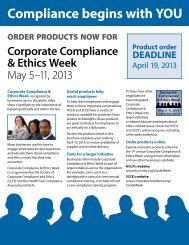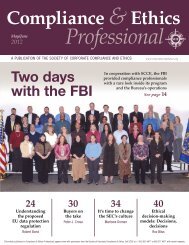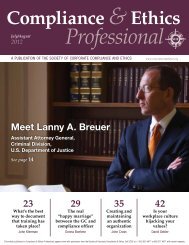Compliance &Ethics - Society of Corporate Compliance and Ethics
Compliance &Ethics - Society of Corporate Compliance and Ethics
Compliance &Ethics - Society of Corporate Compliance and Ethics
- No tags were found...
You also want an ePaper? Increase the reach of your titles
YUMPU automatically turns print PDFs into web optimized ePapers that Google loves.
about to become a headline? And, given theopportunity, what might I suggest they do toanticipate <strong>and</strong>/or prevent that eventuality?The fourth elementIn the time since that meeting, I’ve continuedto ponder the question <strong>of</strong> how an organizationcan avoid becoming tomorrow’s headline.It seems to boil down to three obvious, criticalelements <strong>and</strong> one less than obvious element.It is the fourth element that so many <strong>of</strong> thosewe read about failed to address. The elementsI thought about include:1. Ensuring that all <strong>of</strong> your policies, procedures,<strong>and</strong> practices satisfy the myriadapplicable laws <strong>and</strong> regulations thatare externally imposed upon yourorganization.2. Ensuring that all <strong>of</strong> your leadership practices<strong>and</strong> operational st<strong>and</strong>ards satisfy all<strong>of</strong> the internally imposed rules, st<strong>and</strong>ards,policies, <strong>and</strong> procedures.3. Ensuring that there is a culture withinthe organization that underst<strong>and</strong>s thatadherence to all regulations, practices,<strong>and</strong> operational st<strong>and</strong>ards is the minimumrequirement for success.4. Ensuring that there is a corporate culturethat reaches for the highest ethicalst<strong>and</strong>ards—one that does not settle forconformance to minimal st<strong>and</strong>ards.But how can a company that is striving tosucceed in a highly competitive environment,in the midst <strong>of</strong> an economic downturn, <strong>and</strong>fighting for market share compete with companieswho do only what the law requires?Doesn’t doing more cost more? Yes, it does,in the short run. But how many <strong>of</strong> us are in itfor the short run? How many <strong>of</strong> us work forcompanies that have a self-imposed expirationdate? How many <strong>of</strong> us work for boardsthat are only concerned that the organization’sinevitable failures not occur on their watch?If the fourth element can be understood asthe difference between short-term <strong>and</strong> longtermviability, then there is an argument to bemade that boards <strong>and</strong> others might accept. Butcan we make that argument?In dealing with the client noted above Iconcluded that they had bought into the “compliance”model. They were “hooked” on theopiates <strong>of</strong> compliance <strong>and</strong> best practices. Theysaw no merit in the “ethics” model. After all,the law did not require more <strong>of</strong> them thanthey were already doing.Sadly, they were three quarters <strong>of</strong> the waythere. They had successfully met the first three<strong>of</strong> the four elements needed to avoid becominga headline. To borrow a baseball metaphor,they had reached third base. Their ethics <strong>and</strong>compliance program was a model <strong>of</strong> “bestpractices.” But you get no points for str<strong>and</strong>ing arunner on third. Hitting a triple may look greatin your individual statistics, but it doesn’t countfor much if the team loses because you failed toget the runner home. They seemed willing toaccept that crossing the t’s <strong>and</strong> dotting the i’s <strong>of</strong>compliance was their goal.How might I have argued for the fourthelement? What might I have said or doneto better communicate the critical value <strong>of</strong>ensuring that there is a corporate culture thatreaches for the highest ethical st<strong>and</strong>ards—one that does not settle for conformance tominimal st<strong>and</strong>ards? How might I have bettercommunicated that diagnosis is not a solution?Diagnosis is not enoughDiagnosis helps us underst<strong>and</strong> what is goingon, but it may not always lead us to why it isgoing on—the causes behind the outcomeswe are experiencing. Absent that “why” data,management is forced to rely on guessworkregarding causes. Unless you can access thatdata <strong>and</strong> then act on it, you have minimalcertainty that the solution at h<strong>and</strong> is, in fact,going to solve anything.<strong>Compliance</strong> & <strong>Ethics</strong> Pr<strong>of</strong>essional May/June 2013+1 952 933 4977 or 888 277 4977 www.corporatecompliance.org 63




